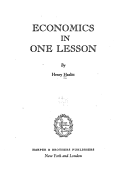Quotes from book
Economics in One Lesson

Economics in One Lesson is an introduction to economics written by Henry Hazlitt and first published in 1946. It is based on Frédéric Bastiat's essay Ce qu'on voit et ce qu'on ne voit pas .The "One Lesson" is stated in Part One of the book:
